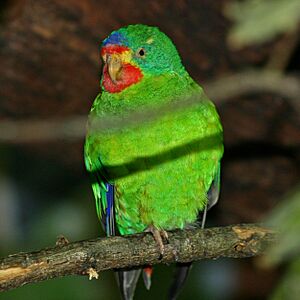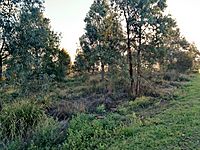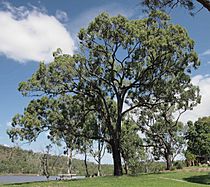Cumberland Plain Woodland facts for kids
Quick facts for kids Cumberland Plain Woodland |
|
|---|---|

The Cumberland Plain Woodland region lies far-west of Sydney (light pink on map).
|
|
| Ecology | |
| Realm | Australasia |
| Biome | Temperate grasslands, savannas, and shrublands, Mediterranean forests |
| Borders | Eastern Australian temperate forests |
| Geography | |
| Country | Australia |
| Elevation | 10–100 metres (33–328 ft) |
| Coordinates | 33°50′59″S 150°54′40″E / 33.84972°S 150.91111°E |
| Geology | Sandstone, shale, laminite and siltstone |
| Climate type | Humid subtropical climate (Cfa) |
| Soil types | Clay, sand (podsol), loam |
The Cumberland Plain Woodland is a special type of forest found in Sydney, New South Wales, Australia. It's one of six main natural woodland areas in Sydney. This woodland has tall trees, a layer of shrubs, and a ground covered with grasses and herbs.
It's located in an area called the Cumberland Plain. This area features dry woodlands, grasslands, and forests. These look a bit like the forests you might find in places with a Mediterranean climate or in temperate grasslands.
Sadly, not much of the Cumberland Plain Woodland is left today. Less than 6% remains, spread out in small patches across the western parts of Sydney. This totals only about 6,400 hectares. Because so little is left, the Cumberland Plain Woodland was officially listed as an "Endangered Ecological Community" in 1997. This means it's at risk of disappearing forever.
The biggest dangers to this woodland are clearing land for farms and new buildings (called urban sprawl). Also, new types of harmful weeds can take over and push out the native plants.
Contents
Exploring the Cumberland Plain Woodland
Where is the Woodland Located?
A long time ago, in 1877, the Cumberland Plain Woodlands covered a huge area of 107,000 hectares. This was about 30% of the entire Sydney Basin. When European settlers first arrived, there were about 1,070 square kilometers of woodlands and forests here.
But as Sydney grew westward, more and more land was cleared. This put a lot of pressure on the woodlands. Now, only about 13% of the original woodland remains untouched.
You can find parts of the Cumberland Plain Woodland in cities like Fairfield, Liverpool, Cumberland, Campbelltown, Blacktown, and Penrith. These areas hold about one-fifth of the remaining woodland.
Climate and Landscape of the Woodland
This special area has clay soils that come from a type of rock called Wianamatta Shale. It's in a "rain shadow" area, which means it gets less rain. Usually, it receives about 700–900 mm of rain each year. This is less than other parts of Sydney.
The woodland is mostly found on flat or gently hilly land, up to about 350 meters high. Sometimes, you might see it on steeper slopes or at slightly higher elevations. The trees form an open canopy, meaning there's space between them. The ground is covered with grasses and herbs, and sometimes there are layers of shrubs and smaller trees too.
You can visit some of the remaining woodland areas in places like Scheyville National Park, Rosford Street Reserve, Brenan Park, and Central Gardens Nature Reserve. Other spots include Prospect Nature Reserve and Wetherill Park Nature Reserve.
Types of Woodland Areas
The Cumberland Plain Woodland includes several different types of woodland areas. Some of these overlap, and others are smaller parts of the main woodland. Here are a few examples:
- Cumberland Moist Shale Woodlands: These are found in protected areas. They have shrubs with waxy leaves and small trees. The ground is covered with herbs, vines, and grasses. You can find small parts of this woodland in the southwest of Fairfield City Council and northwest of Liverpool.
- Cumberland Shale Hills Woodland: This is a common type of grassy woodland within the Cumberland Plain. It grows where the rainfall is between 750 and 900 millimeters per year and at elevations of 50 to 350 meters. It's an open woodland with grey box and forest red gum trees. You can see it near Prospect and on the western edges of Fairfield and Liverpool.
- Cumberland Shale Plains Woodland: This woodland is found on flatter land. It's an open grassy woodland with grey boxes, forest red gums, and ironbark trees. It also has a good cover of grasses and forbs (flowering plants). This type is common around Wetherill Park and Greystanes.
- Western Sydney Dry Rainforest: Most of this type of rainforest has been cleared. It grows on clay-rich soils in the wavy hills of western Sydney. The grey myrtle tree is very common here. Other trees include fig and wild quince.
- Cumberland Shale-Sandstone Ironbark Forest: This forest is found at the edges of the Cumberland Plain. It's where the clay-rich shale soil meets the sandy soil from the sandstone plateau. It's a moderately tall eucalyptus forest with a mix of shrubs and grasses.
- Shale/Sandstone Transition Forest: This forest is also found at the edges of the Cumberland Plain, where the clay and sandy soils meet. It's a moderately tall eucalyptus forest.
- Shale Gravel Transition Forest: This forest has sandy soils with ironstone gravels. It can have dense shrubs or a thinner shrub layer with lots of grasses. It's mostly found in Prospect and Holsworthy.
Plants of the Woodland
The woodlands grow on soil that isn't very rich in nutrients. This soil comes from sandstone and shale rocks in the Blue Mountains. Even so, these woodlands support a huge variety of plants and animals!
The Cumberland Plain Woodland is mostly filled with Grey Box (Eucalyptus moluccana) and Forest Red Gum (E. tereticornis) trees. You might also see Narrow-leaved Ironbark (Eucalyptus crebra) and Spotted Gum (Corymbia maculata).
There's often a layer of smaller trees like Acacia decurrens and Acacia parramattensis. The shrub layer includes plants like Bursaria spinosa and indigofera australis. Many grasses, such as Kangaroo Grass (Themeda australis), cover the ground.
Here are some other types of trees you can find:
- Eucalyptus amplifolia (cabbage gum)
- Eucalyptus sieberi (Silvertop Ash)
- Corymbia gummifera (red bloodwood)
- Eucalyptus racemosa (scribbly gum)
- Eucalyptus melliodora (yellow box)
Other non-eucalyptus trees include:
- Melaleuca alternifolia (snow-in-summer)
- Melaleuca styphelioides (prickly-leaved paperbark)
- Allocasuarina torulosa (forest oak)
- Syncarpia glomulifera (turpentine tree)
Some common shrubs are:
- Pittosporum revolutum (yellow pittosporum)
- Breynia oblongifolia (coffee bush)
- Dichondra repens (kidney weed)
- Daucus glochidiatus (Australian carrot)
And for grasses and sedges:
- Cyperus gracilis (slender flat sedge)
- Oplismenus hirtellus (basket grass)
- Bothriochloa macra (red-leg grass)
Animals of the Woodland
The Cumberland Plain Woodland is home to many animals, including several vulnerable or endangered birds and mammals. Protecting this woodland helps protect these amazing creatures.
Birds of the Woodland

Many bird species live in or visit the woodland. Some of the notable ones include:
- Gang Gang Cockatoo
- Glossy Black-cockatoo
- Brown Treecreeper
- Swift Parrot (which is critically endangered!)
- Square-tailed Kite
- Hooded Robin
- Barking Owl
- Powerful Owl
- Diamond Firetail
- Regent Honeyeater
Mammals of the Woodland
The woodland also provides a home for various mammals, including several bat species and marsupials:
- Large-eared Pied Bat
- Spotted-tail Quoll
- Eastern False Pipistrelle
- Eastern Bent-wing Bat
- Eastern Freetail Bat (a vulnerable species)
- Koala
- Yellow-bellied Glider
- Squirrel Glider
Images for kids
-
The Cumberland Plain Woodland region lies far-west of Sydney CBD.













